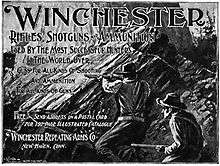.219 Zipper
The .219 Zipper cartridge was created by Winchester Repeating Arms in 1937 to be used in their lever-action Model 64 rifle. It is a 30-30 Winchester cartridge necked down to a .22 caliber bullet. Marlin Firearms also offered their Marlin Model 336 rifle (Marlin 336 Zipper) chambered for the cartridge.
| .219 Zipper | ||||||||||||||||
|---|---|---|---|---|---|---|---|---|---|---|---|---|---|---|---|---|
 | ||||||||||||||||
| Type | Rifle | |||||||||||||||
| Place of origin | United States | |||||||||||||||
| Production history | ||||||||||||||||
| Designed | 1937 | |||||||||||||||
| Manufacturer | Winchester Repeating Arms | |||||||||||||||
| Produced | 1938-1962 | |||||||||||||||
| Variants | .219 Donaldson Wasp, .219 Zipper Improved | |||||||||||||||
| Specifications | ||||||||||||||||
| Parent case | .30-30 Winchester | |||||||||||||||
| Case type | Rimmed | |||||||||||||||
| Bullet diameter | .2245 in (5.70 mm) | |||||||||||||||
| Neck diameter | .253 in (6.4 mm) | |||||||||||||||
| Shoulder diameter | .365 in (9.3 mm) | |||||||||||||||
| Base diameter | .422 in (10.7 mm) | |||||||||||||||
| Rim diameter | .506 in (12.9 mm) | |||||||||||||||
| Rim thickness | .063 in (1.6 mm) | |||||||||||||||
| Case length | 1.938 in (49.2 mm) | |||||||||||||||
| Overall length | 2.260 in (57.4 mm) | |||||||||||||||
| Case capacity | 34 gr H2O (2.2 cm3) | |||||||||||||||
| Rifling twist | 1 in 14 in (360 mm) | |||||||||||||||
| Primer type | large rifle | |||||||||||||||
| Maximum pressure | 42,000 psi (290 MPa) | |||||||||||||||
| Ballistic performance | ||||||||||||||||
| ||||||||||||||||
| Test barrel length: 26 Source(s): Accurate Arms | ||||||||||||||||
While the .219 Zipper was supposed to compete against other varmint cartridges of the time, most lever-action rifles use tubular magazines, which prohibit the use of pointed bullets. This led to problems with accuracy. Winchester stopped producing .219 Zipper ammunition in 1962, Remington Arms stopped production of the cartridge soon afterwards. The .219 Zipper is the parent case of the .219 Donaldson Wasp, and P.O. Ackley created the .219 Zipper Improved in 1937. Leslie Lindahl's Chucker and Super-chucker and "wildcat" case modifications by Hervey Lovell, Lysle Kilbourne, and W. F. Vickery offered similarly superior ballistics in stronger single-shot and bolt actions.[1]
Though the flat- or round-nosed slug causes rapid loss of velocity, the .219 Zipper is suitable for small game or varmints, including wolf or coyote, and even deer if loaded with a heavier 55 grain bullet.[2] It works well in guns designed to fire rimmed ammunition, such as rebarreled Lee–Enfields, but not in Mauser-type actions, which are not.[2]
Note
The ballistics data in the infobox are for maximum loads, as determined by the writers for Accurate Arms. This was based upon the Winchester Model 64 rifle being chambered in .25-35 WCF and .30-30 Winchester rather than SAAMI specifications.
See also
Notes
- Landis, Charles S. Twenty-Two Caliber Varmint Rifles (1947) Small Arms Technical Publishing Company p.60
- Barnes, ".219 Zipper", p.9.
References
- Barnes, Frank C., ed. by John T. Amber. ".219 Zipper", in Cartridges of the World, p. 9. Northfield, IL: DBI Books, 1972. ISBN 0-695-80326-3.
